Final report for FNE18-904
Project Information
To determine, as close as possible, the appropriate linear feed space requirements to maximize the productivity of broiler chickens and laying hens raised on pasture. For meat chickens this means providing birds with varying amounts of feeder lip space in each movable open-floored pen and weighing a portion of the birds at intervals, and before harvest, to determine if the birds grew at different rates, thereby discovering if more or less feeder lip space impacts growth rate and to what degree. We collected very accurate data for nine different batches of meat chicks over several months, provided different linear feed space and tracked growth rates by weighing 25% of each group. For egg laying hens we split our layer flock into subgroups and changed feeder lip space to see if birds laid less or more eggs. All birds were provided free choice unlimited amounts of feed. In each scenario reducing feeder lip space to .8" (or less in the case of the egg layers) or providing as much as 2.5" did not appear to affect growth rate for meat birds. Questions remain if our sample size of weighing 25% of the birds truly represented the entire group of each batch and how our results, assuming they are accurate, translate as batch sizes are scaled up. For instance, would the same result if our groups of birds were 500, 1000 or more?
We presented our findings at several farmer conferences and our results will be posted on our website (codmanfarm.org) and an article will be published in the APPPA Grit newsletter in 2019.
To determine, as close as possible, the appropriate linear feed space requirements to maximize the productivity of broiler chickens and laying hens raised on pasture. For our purposes, the definition of appropriate means that birds are meeting or exceeding industry standards for productivity: Laying hens are laying at or above their expected rate of lay while maintaining body weight, egg size, health and vigor. Broiler chickens will be meeting or exceeding final carcass size based on breeder growth charts for the particular breed in production. With productivity goals being met we aim to determine the minimum amount of linear feed space needed to reach this maximum productivity. Maximum productivity will then result in healthier and more robust livestock and higher net income for the grower.
This project was created to assist farmers in determining the appropriate amount of feeders needed for raising meat birds and laying hens on pasture. Pasture-based poultry growers face the daunting task of trying to be profitable in this niche sector with little research to support their efforts since most guidance on feeder lip space provided by feeder manufacturers or in other publications are primarily based on the needs for commercial poultry farms using barn systems containing thousands of birds but there are hundreds of small-scale pastured poultry growers who have little research to turn to for accurate information.
Over 50% of the operating costs to run a pastured-poultry farm derive from grain costs and labor. Determining the optimal feed lip space requirement is critical and will help farmers be profitable and successful by maximizing their poultry productivity through efficient feeding systems and labor inputs. This research will help growers in three dramatic ways. First, it will increase growers’ profitability by ensuring they are providing enough feed space to maximize productivity of the species of birds they are growing. Even a small uptick in egg production or weight gain in broilers can equate to thousands of dollars of increased revenue which often makes the difference between a net loss or net profit. Second, this will allow growers to build/purchase exactly the amount of feeders needed without over buying/building. It will allow growers to provide the exact labor needs required in managing their feeding systems. Growers will no longer be filling feeders that they don’t need. This research is the beginning of a wider effort to create more efficient feeding systems for pastured-poultry growers.
Earlier this year I began researching the simple question “how much feed space do birds need on pasture?” When I consulted industry experts, the definitive answer to this simple question started to become elusive because ultimately no one has done this type of research for poultry production on pasture. All the guidelines on feeding are for conventional barn raised or caged systems where bird density is extremely high. The current guidelines in various publications vary from .5” of feed space per bird to over 4”. A Virginia Tech fact sheet by Phillip J. Clauer, Poultry Extension Specialist, Animal and Poultry Sciences, indicated 3” of lip space needed per bird and others referenced for this same publication list 4” with this particular publication targeting smaller growers. Most guidelines refer to “consult the manufacturer” of the feed system itself. I have and the guidance is equally unclear. Kuhl which manufactures plastic gravity feeders in use by many small scale growers provides the following
guidance, as an example. According to Kuhl a 300 lb range feeder they sell is capable of feeding 300 birds, yet it has only a feed lip space of 95”. At the commonly referred to space requirement of 3” per bird this feeder should only feed 31.6 chickens. Even at the lowest recommended space of .5” this feeder could only adequately feed 190 chickens, yet it is rated to feed 300 birds. How is this possible? It is thought that some of the guidance given by manufacturers has more to do with the feed storage capacity of a feeder rather then its actual linear feed lip space. Laying hens consume .25lbs of feed per day so this feeder could potentially feed 1200 birds with this storage capacity. So why do they not recommend this feeder for feeding 1200 birds? There are countless examples of this type of wildly different recommendations by publications, experts and manufacturers.
Animal advocacy groups provide guidance but the information is limited. Animal Welfare Approved guidelines state ”Birds must have a feeding plan that will guarantee a varied, well-balanced and wholesome nutritional regime appropriate for their age” and also state, “Food and water must
be distributed in a way that eliminates competition”, “Poultry must have constant access to food during daylight hours” This guidance also precludes some pasture poultry producers from feeding in a cleanout method which ensures the birds consume all their feed in a given day, often in two feedings per day. Humane Farm Animal Care Standards indicate that managers should “ensure that feed is easily available to hens, producers must provide each hen with at least: a. 2.0 in. (5 cm) of (actual) linear track (for double sided) b. (4.0 in. (10 cm) of linear track for (for single sided) or c. 1.5 in. (4 cm) of perimeter space for circular feeders.” These guidelines are general and fall within the median of space requirements observed in many publications but again, no research has been conducted in this area.
Cooperators
- Jeff Mattocks - Technical Advisor
Research
Our project goal was to determine if altering feeder lip space for both layers and meat birds affected rate of lay or in the case of meat chickens, rate of growth, feed conversion or any other aspect of growth. We followed the guidelines set forth in our project proposal.
Meat Chickens (broilers)
We collected data on a total of nine (9) separate batches of meat chickens, including five different strains of birds. We have always grown and trialed a variety of meat birds each season to experiment with new genetics so we felt it would be interesting to also measure growth differences for these different strains. Our birds arrived as day old chicks in the mail, in groups varying form 70 to 180 chicks (see chart below). All our chicks were placed in our brooder barn and were fed a certified organic 21% mash from Green Mountain Feeds. Birds were grown for their first three weeks in ohio brooders with two heat lamps, peat moss or pine shaving bedding and had free access to feed, clean water, chick grit and uniform amounts of feeder lip space. We began altering feeder lip space only when the birds were moved to pasture. Each day feed consumption was measured for each group and logged in a web-based digital form created with a Zoho forms tool. At three weeks of age the birds were crated and moved to 8'x12' open floored pens located on a 12 acre pasture managed by the farm. Upon moving to pasture pens 25% of the birds were weighed to form a weight baseline and either 1, 2 or 3 round Kuhl BL-50 feeders were hung inside each pen providing either .8, 1.6 or 2.5 inches of linear lip space per bird. The stocking rate in our study was about 1.47 birds per square foot.
We had initially planned to hang as many as 4 feeders in a coop but quickly realized this was way too much lip space and was not needed. Upon moving birds to pasture, birds were fed a 19% grower crumble ration and were provided unlimited feed and appropriate sized grit in a separate grit tray in each pen. We raised a total of 24 different batches of birds but for this study we only analyzed the batches listed below. Birds were confined to their pens and did not day range.
| BATCH CODE | BREED & HATCH DATE | SLAUGHTER DATE |
| 1F | Freedom Rangers, 3/27/18 | 5/31/18 |
| 4F | Freedom Rangers, 5/22/18 | 7/26/18 |
| 5F | Freedom Rangers, 7/12/18 | 8/16/18 |
| 1C | Cornish, 4/3/18 | 5/31/18 |
| 4C | Cornish, 5/29/18 | 7/26/18 |
| 1RB | Red Bro M14, 3/27/18 | 5/31/18 |
| 1Ross | Ross 308, 4/3/18 | 5/31/18 |
| 1RobWh | Robust White, 4/3/18 | 5/31/18 |
Data Collection
An important part of our research was collecting data in the field. Creating simple and functional forms and mandating their use greatly improved our dedication to the data collection process and the quality of our management. After much research we settled on an inexpensive web based platform with a very easy to use mobile app called Zoho Forms, which cost $10 per month. While we were primarily interested in feed consumption, mortality and tracking bird growth weights, we used the forms to also help us perform our daily chores more uniformly across all staff members. After using these forms for a short while we concluded they were so easy to use and provided such great data we would continue to use them after the conclusion of the grant. We created multiple forms to capture field data including:
- Brooder Chore Form - Form_Brooderchore - Where we collected information for each batch of birds including: Batch #, Mortality and causes, feed consumption, water and bedding checks, general notes and photo capture field.
- Each day an employee checked on the chicks growing in the brooder. The employee fed the birds, provided fresh water, added bedding, tracked deaths and cause and logged the data.
- Broiler Field Chore Form - Form_Broilerfieldchore - Where we collected information for each batch of birds including: # of birds initially placed in each coop, batch, #, coop #, mortality and causes, amount of feed fed out that day, # of feeders per coop, grit level, general health observations, general notes, and a photo capture field.
- Each day an employee or two moved the broiler pens forward one length on pasture, then provided feed, refilled waters, and collected the data included on the mobile form. No matter the quantity of feeders in each pen, each feeder was kept at a level so each was never empty the following day when chores were done. We weighed one standard bucket of feed and used this as a standard for feeding each day. One bucket of feed weighed 23lbs and this figure was multiplied if we fed out multiple buckets to a group in a pen.
- Broiler Weight Collection Form - Form_Broilerweightcollection - where we collected information for each batch of birds including: Batch #, coop #, # feeders per coop, weight of birds (17 collected per group), auto calculation field to provide weight average. comment section, photo capture field.
- Depending on the group, birds were weighed at semi-regular intervals to determine weight gain during the trials. Birds were also weighed live the day before slaughter to determine final live weight in order to compare with other groups. A bucket was suspended from the coop and a hanging scale (tared to account for bucket weight) was used to determine the weight of each bird. We first caught 25% of the birds and placed them in crates within the coop and then as we weighed each bird we released them back into the coop. This way we guaranteed we didn't weigh the same bird for that round of weighing.
To track each batch of birds from the brooder to the field each batch was labelled with a batch code when they arrived from the hatchery and this label was kept with the batch through their lifetime on the farm. When moved to the field each coop was labelled with the batch code, coop # and bird hatch/harvest date in order to minimize confusion when entering the data each day
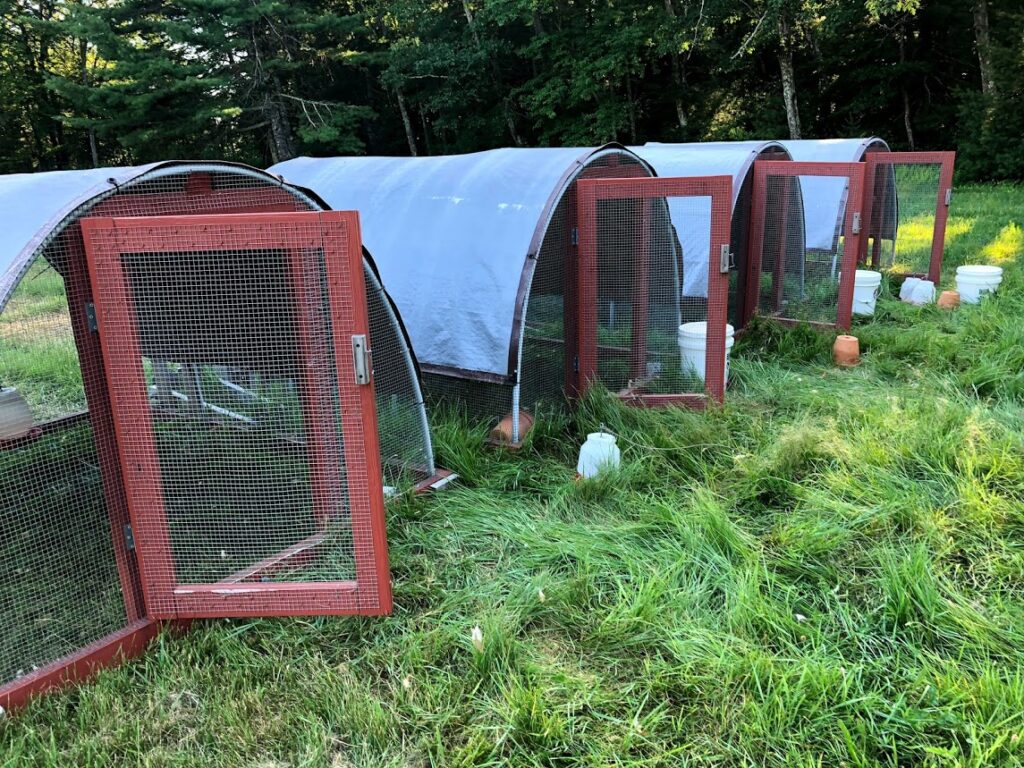
Small broiler pen
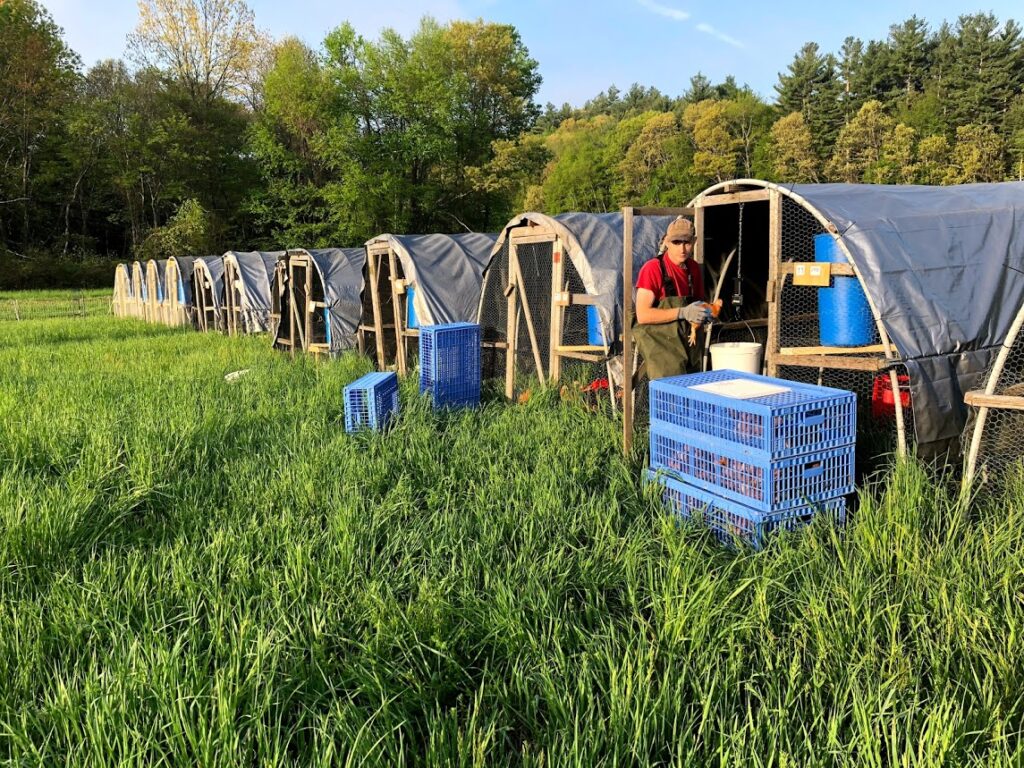
Note the image below with the coop # (5 in this case), batch # (1C in this case) and then we list the breed of bird and their hatch/harvest date.
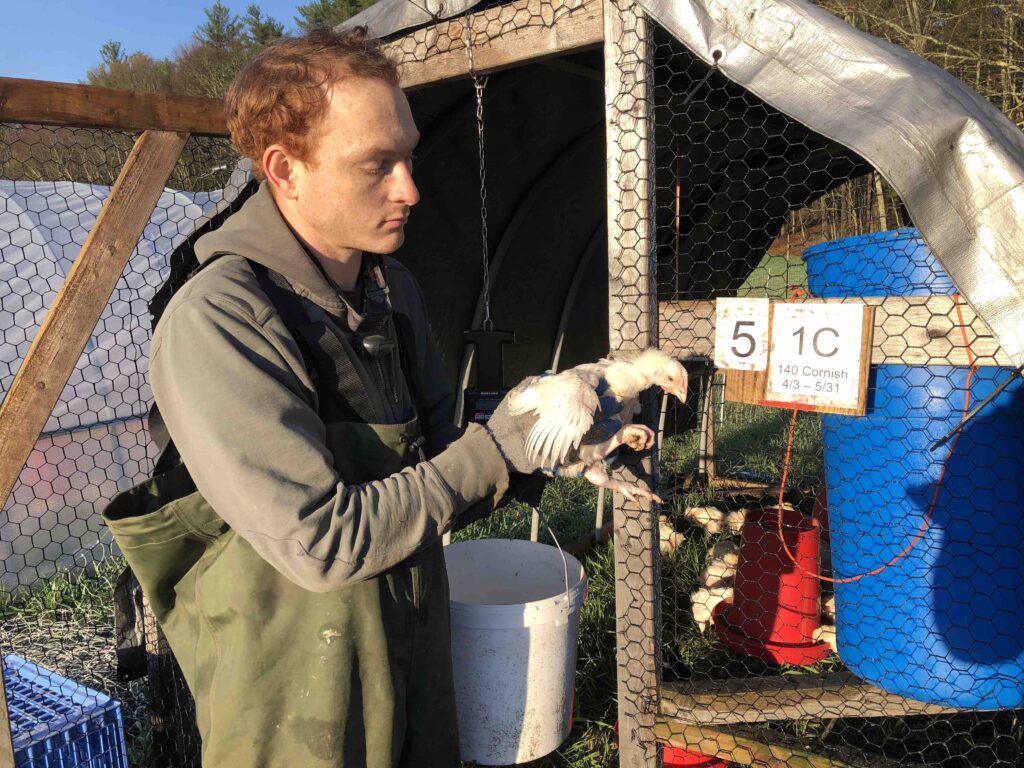
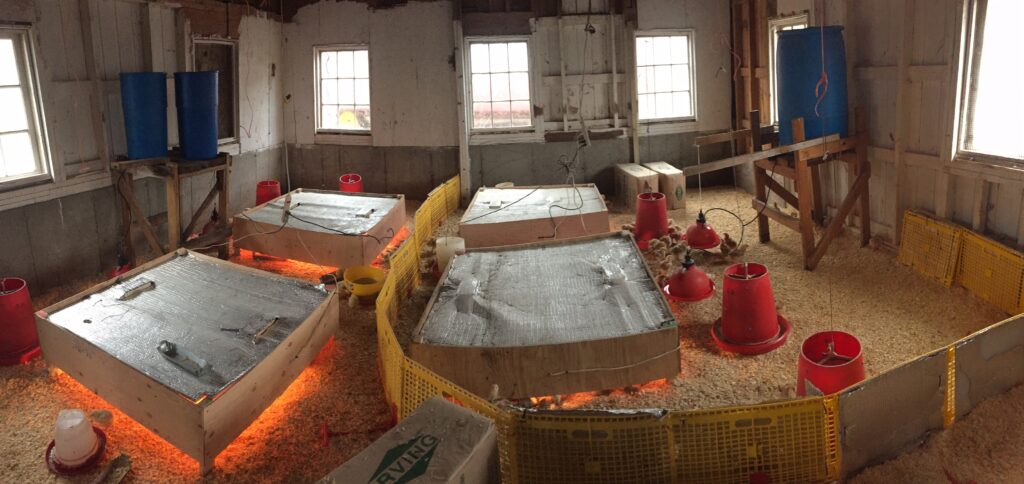
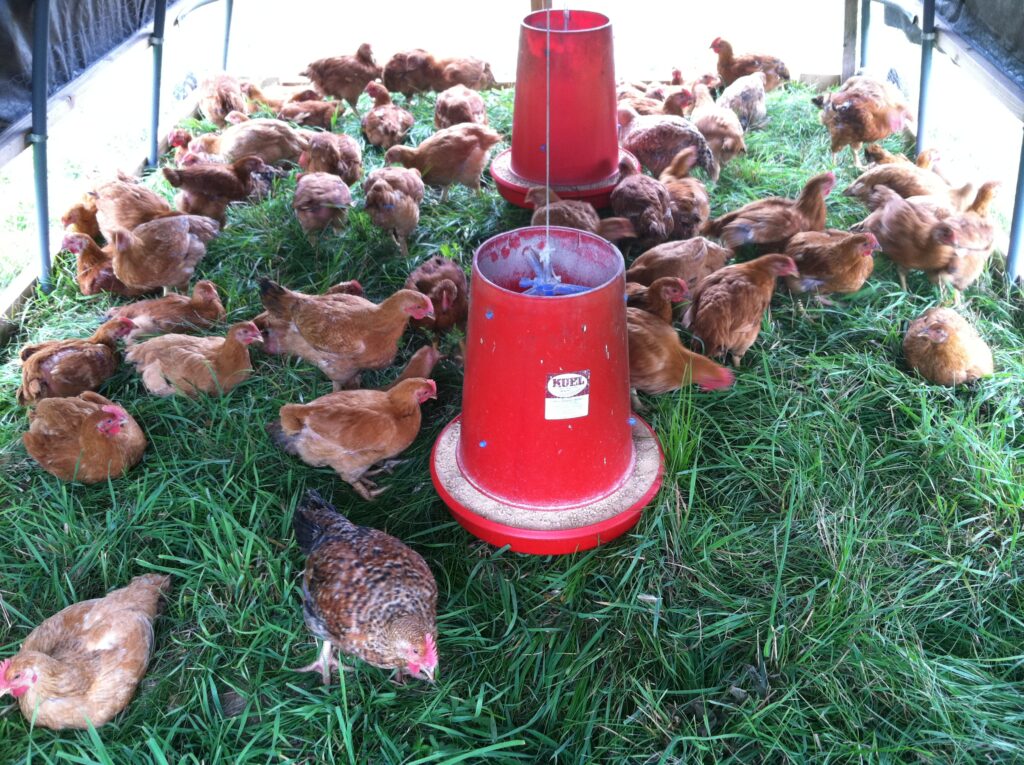
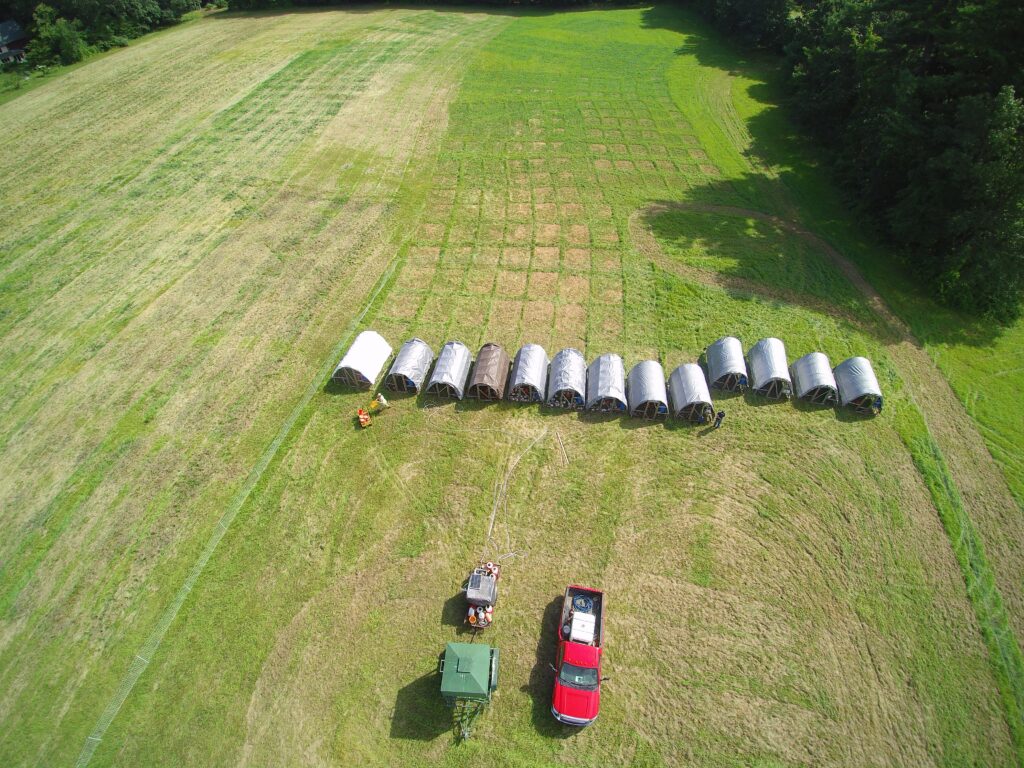
Egg Laying Hens
In addition to measuring productivity of meat chickens with varying feeder lip space we also performed a short study looking at varied feeder lip space on egg layer productivity. Over a six week window we gathered data on any change in rate of lay from our prior years flock of ISA brown hens (at the time of study the birds were 16 months old). We decided to study our older layer flock as we were due to retire them from production shortly and it mattered less to us if their performance declined due to reduced feeder lip space. The birds were moved to pasture from their winter quarters on April 28th. Their rate of lay was stable at that point at 85% with a combined flock linear lip space of 1.65".
Upon moving the birds to pasture in mobile hen houses we created two separate areas adjacent to one another using electrified net fences to contain each group. Each group had a coop containing nest boxes with at at least one box per five hens. The larger control flock had 450 hens and the smaller trial group had 150 hens. Each was fed a 16% organic layer pellet from Green Mountain Feeds along with layer grit and oyster shells in separate feeders for free choice feeding.
Once the birds were moved to the field the control group had a total linear lip space of 1.22". Average feed consumption for laying hens is .25lbs per bird per day. But for this study we did not measure feed consumption or amount of feed fed per day. We were solely focused on rate of egg laying. The test group had only a trailing feeder we built here on the farm which could hold several hundred lbs of feed and had feed access on both sides of the feeder with total lip space of 96" resulting in the test group having .64" of lip space per bird at the outset of moving the birds to pasture.
Each day eggs were collected and weighed. Over the first three weeks we saw no difference in rate of lay between the control group and the test group. At the third week we sealed off one side of the feeder, further reducing feed lip space to .32". The 150 birds in this test group continued to lay at 85% through another three weeks upon which we no longer needed the hens and they were all retired. We had planned but did not weigh any birds from either group at the end of this trial.
This is our Egg Collecting Log Form- Form_Eggcollectinglog - Where we collected data on egg production including: group of hens, number of eggs laid on the ground (for internal reasons), bucket weight (which was used to approximate # of eggs laid each day).
- Eggs were collected 1x per day, feeders were topped off and ensured they never ran out of feed. Buckets of eggs were then weighed daily to determine total weight of eggs collected.
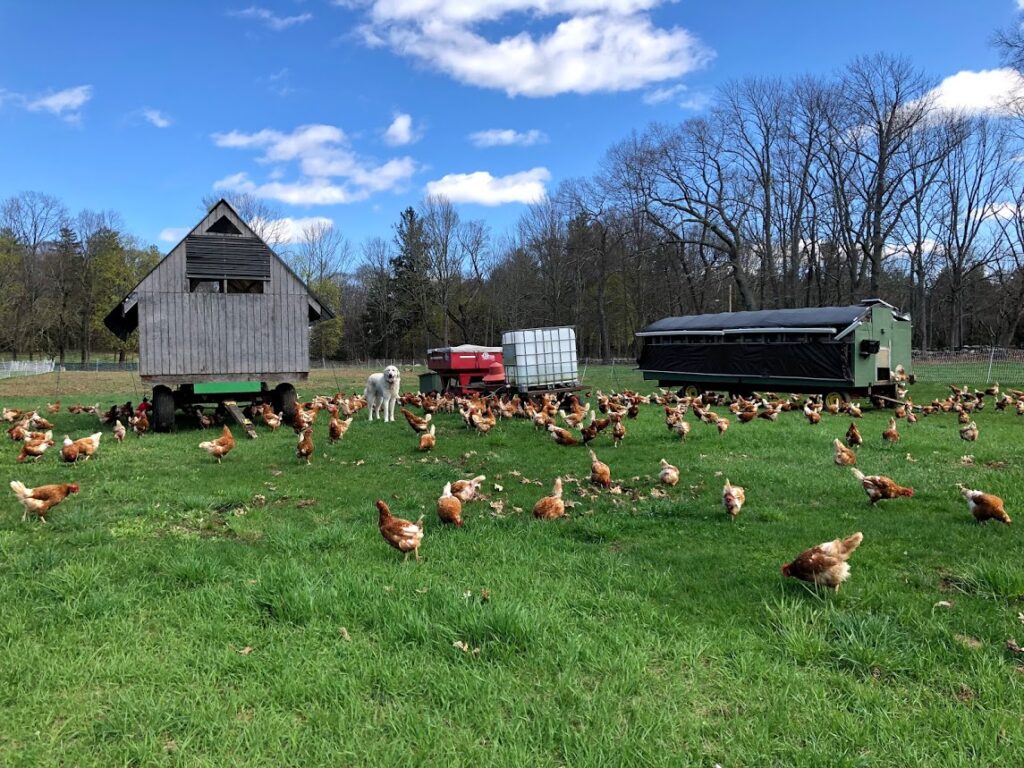
During this project we tracked feed consumption, weight of birds at varied times during grow-out on pasture, and linear feed space per coop with the goal of ascertaining if a change in linear lip space affected growth of meat chickens in any way. Mortality in the field was also tracked with most groups achieving less that 5% mortality due to varied reasons including heart attacks, some predation, and other misc causes.
At the end of the study the data was exported to an Excel spreadsheet and analyzed. Upon reviewing the data we discovered some groups had errors from entering wrong coop information or batch codes so significant effort was spent combing through the data to get uniform data sets which we were confident in analyzing.
Table 1 (below) summarizes our data for the final live bird weight for each group. To determine if feeder lip space affected the final bird weight, we looked at the average and standard deviation in weight. While we do see differences in bird weight among the different varieties, we did not see a significant difference among the groups of the same variety when considering the weight variation (std. deviation) within the group.
We also tracked the feed consumption for each group by tabulating the daily average feed consumption per bird (total amount of feed divided by the number of birds in the coop on that day). This results in the total feed per bird up until slaughter. We used this number divided by the average weight per bird to calculate the feed conversion rate for each batch. The feed conversion rates were very similar within a variety. The small difference observed did not correlate with the available feeder lip space. We also compared the feed conversion we observed with industry standard and we met or exceeded industry standard growth rates.

Figures 1-3 show the average final bird weight and standard deviation for each batch versus the available feeder lip space per bird. The graphs show no significant difference between the groups, and no significant trend with feeder lip space.
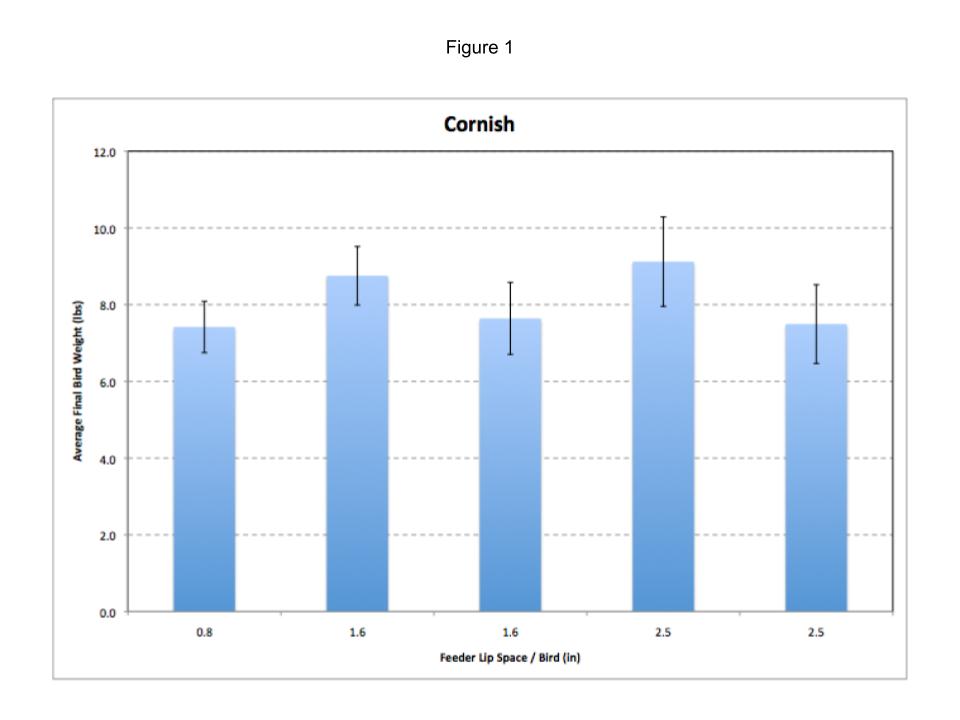
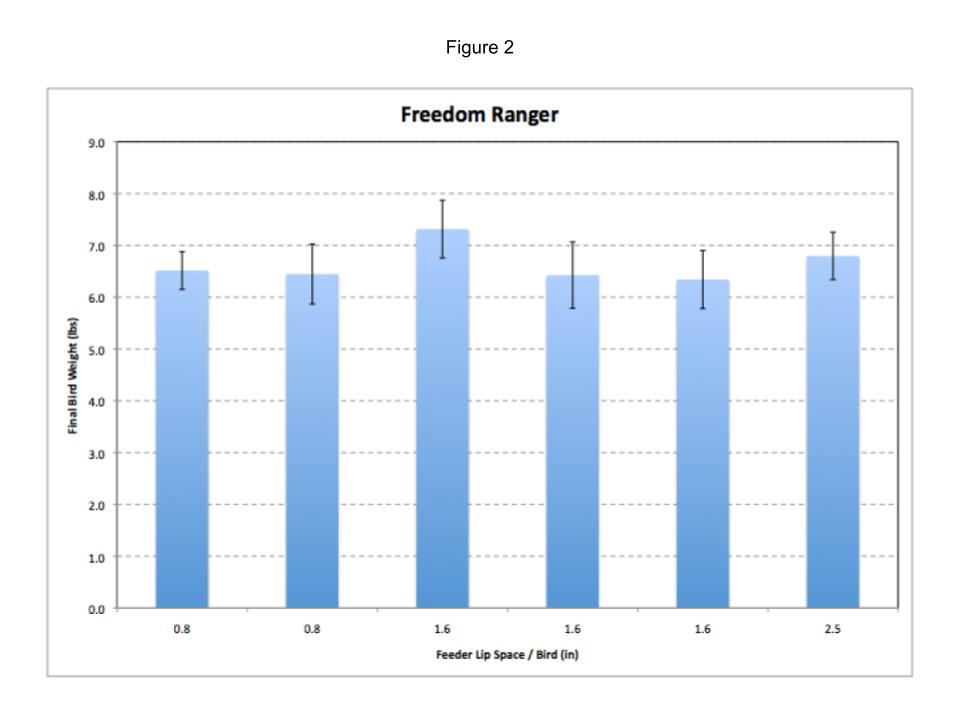
Figure 3 (below) includes data for birds kept in the smaller coop. Here also, we do not see a significant difference in final bird weight when compared to the larger coop.
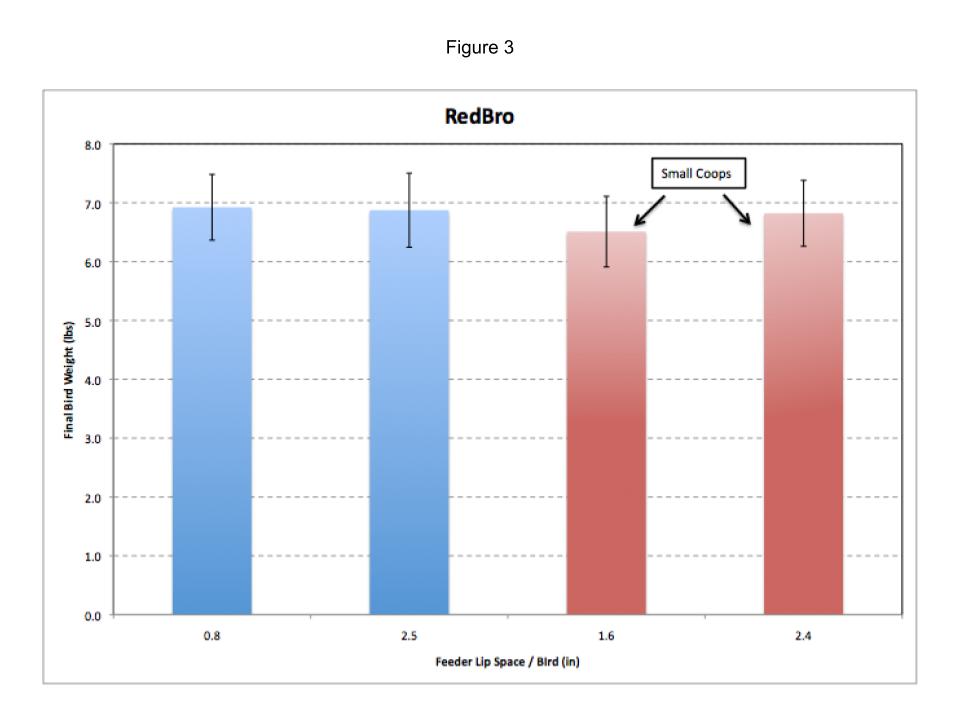
Figures 4-6 show the magnitude of the standard deviation for each batch versus the available feeder lip space per bird. Prior to this experiment, we hypothesized that lower feeder lip space might cause a larger variation in bird weight as larger, more aggressive birds might crowd out smaller birds. The data collected does not show this to be the case; we do not see any trend between the standard deviation and feeder lip space per bird.
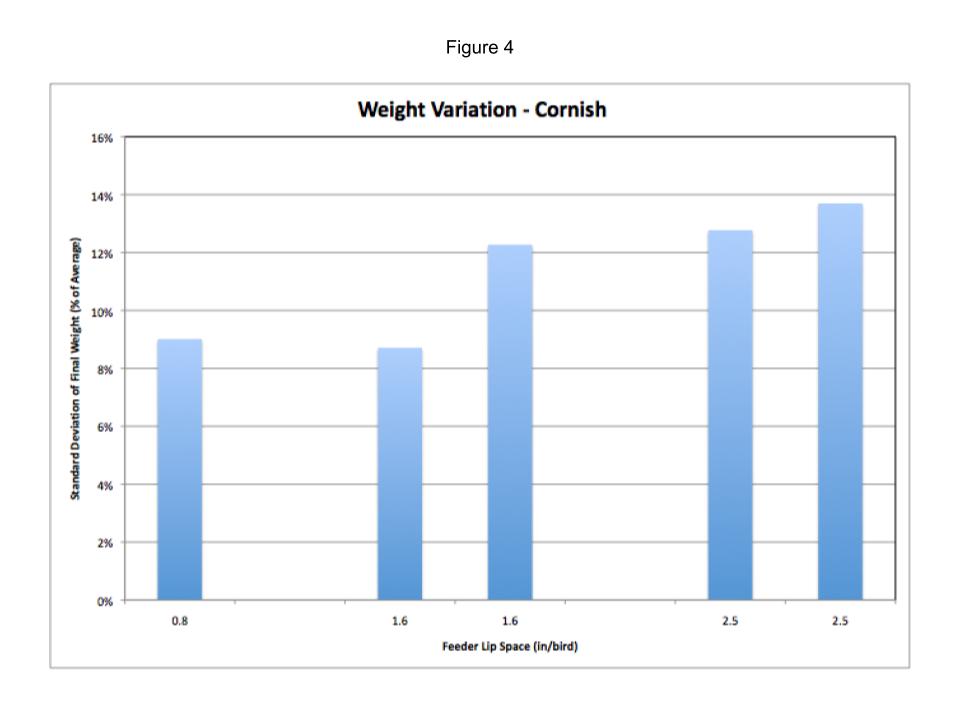
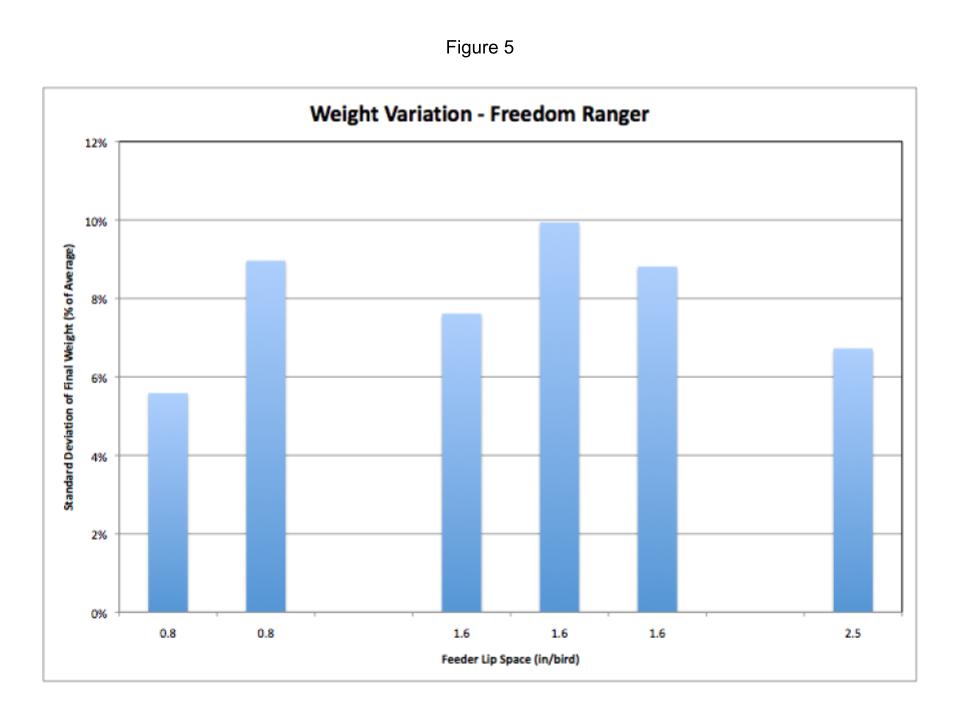
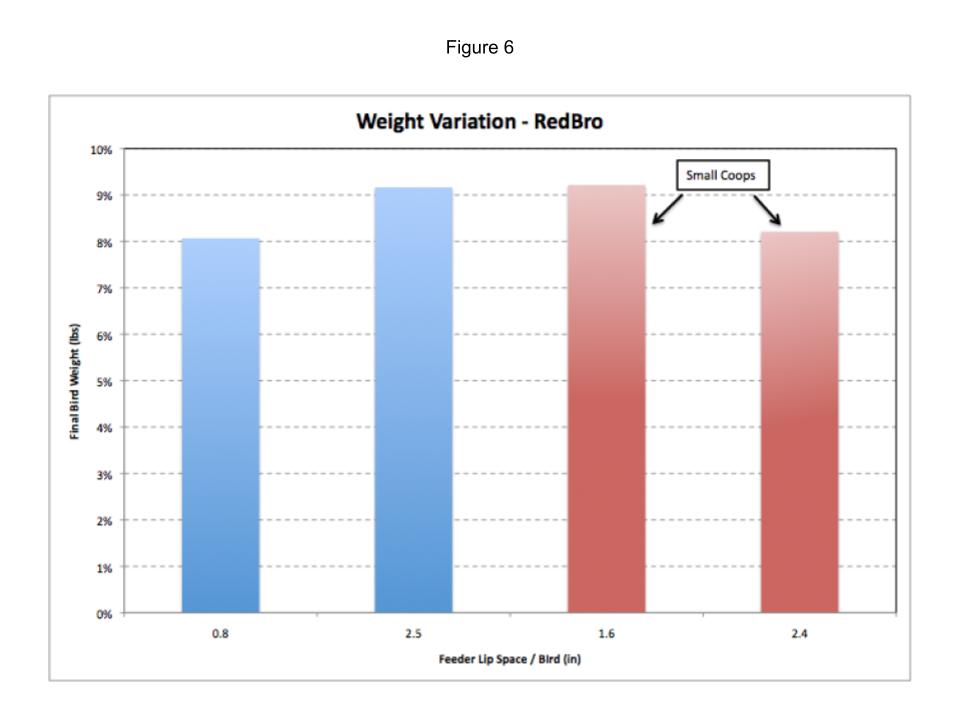
In addition to the final weight statistics, we periodically collected live weight data for several of the batches. Figures 7-9 (below) show the average bird weight for each batch versus bird age (days from hatch) for different amounts of linear lip space. These graphs show no significant difference among the batches in terms of growth rate. The error bars represent ±1 standard deviation of the average live bird weight.
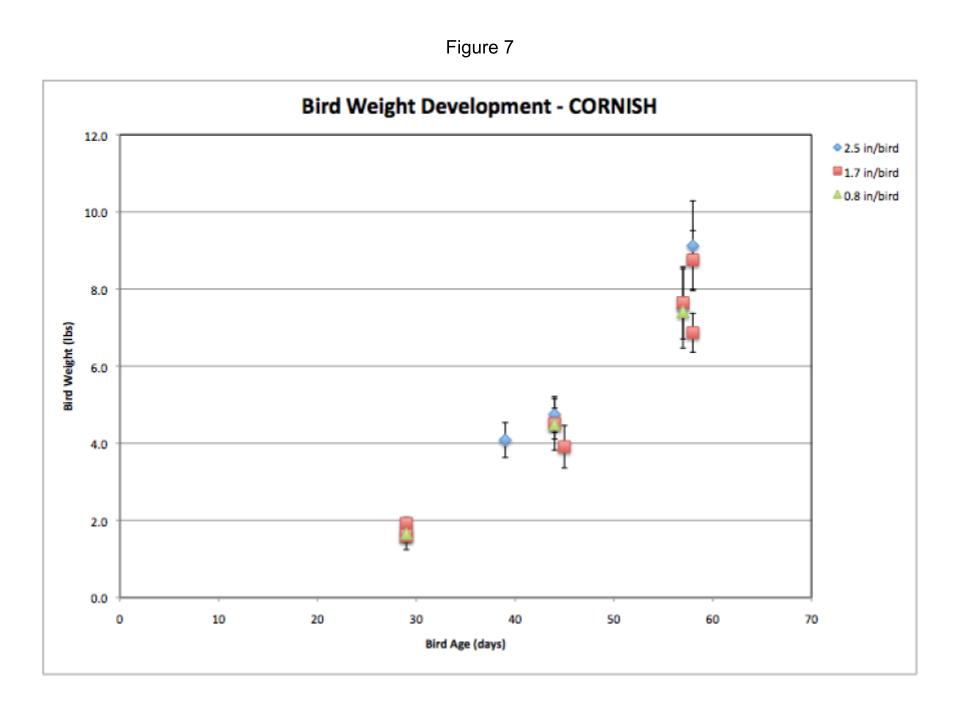
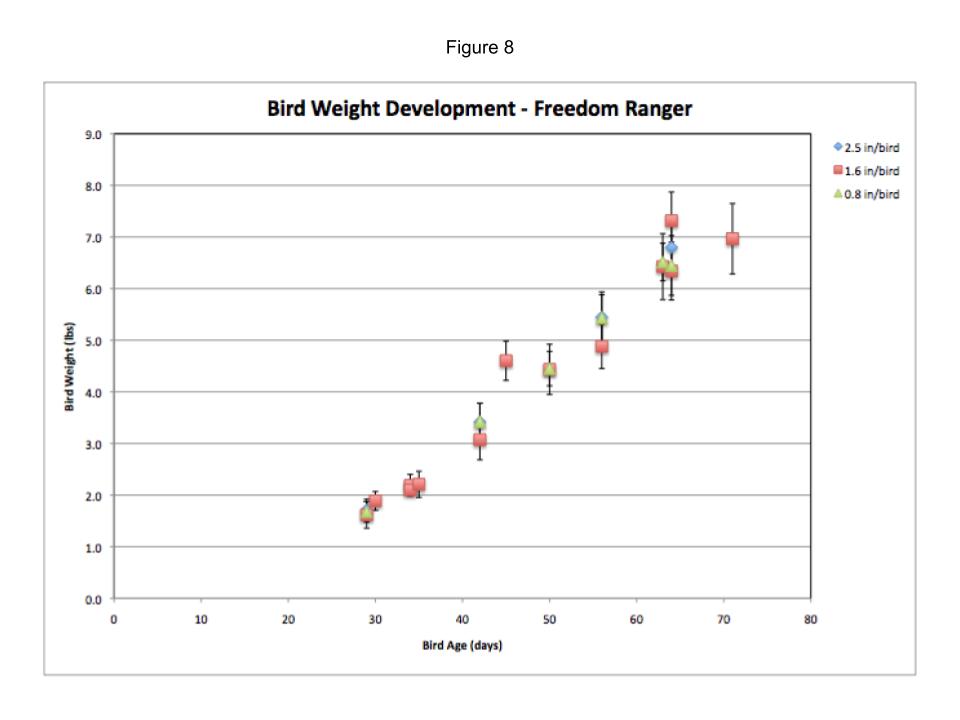
Figure 9 (below) also shows the data for the birds kept in the smaller coop (open symbols). No significant difference in growth rate is observed when compared to the larger coop size.
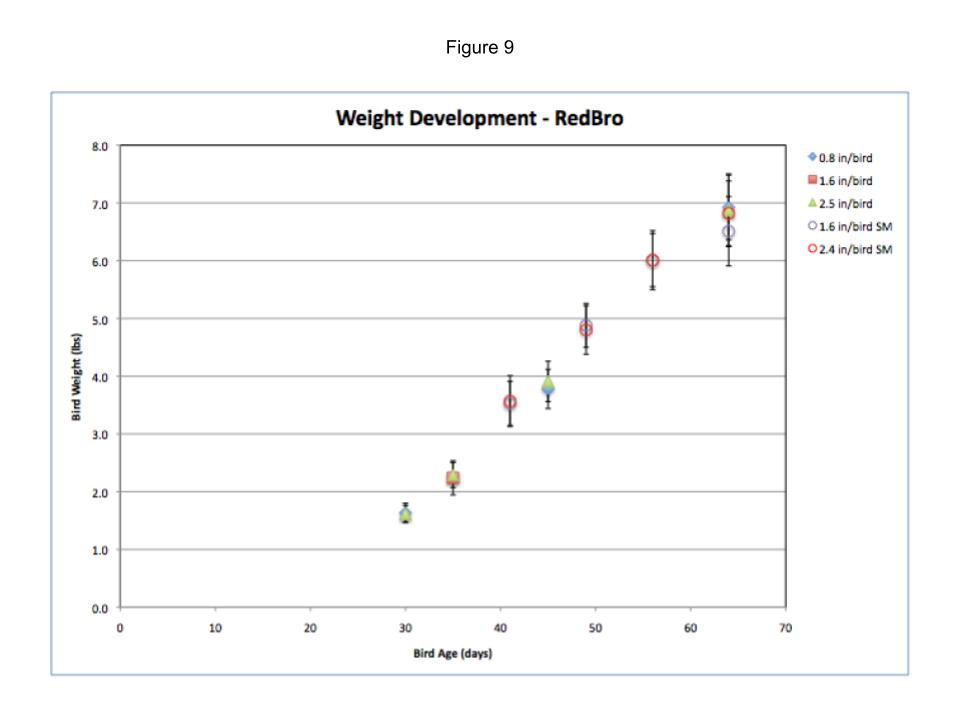
Our final results indicate that linear feeder lip space does not appear to affect either weight gain or egg laying production within the parameters of our study with the number of birds in a group or the stocking rate of 1.47 birds per square foot, with the caveats listed below. It appears that both types of birds adapt to a reduction in linear feed space and as long as their is a large enough reservoir of feed to keep a consistent amount of feed available to the birds, they remain highly productive. Based on these results farmers can reduce the number of feeders they provide to both laying hens and broilers without negatively affecting their production. This can result in savings of significant capital expenditures in the form or purchased feeders and time spent moving and filling feeders.
However, we do believe that further study is merited based on several unanswered questions.
- Were the sample size of our groups adequate? We weighed 25% of each batch of meat chickens but it is unknown if this sample size was truly representative of the entire group of 65 chickens in each group. If we weighed 100% of the birds would the result be the same?
- We measured groups of 65 birds and groups of 20 birds confined to field shelters with stocking rates of about 1.47 birds per square foot. If the groups of birds were larger and/or a higher stocking rate but with the same feeder lip space would the results be the same? What if we had groups of 500 birds which some pastured-poultry growers are now doing, would the results be the same? Would there be a difference between breeders, as Cornish are more sedentary then Freedom Ranger type birds and perhaps this could result in a different outcome.
Education & Outreach Activities and Participation Summary
Participation Summary:
In late January 2019 a short presentation was made at the annual APPPA conference in Texas. 190 poultry farmers attended the conference and were present at the presentation where we discussed our project history and findings. One on one discussions were held with growers interested in learning more about our project throughout the two day conference.
In late January 2019 we presented at the annual Livestock Conference put on by the Livestock Institute in southern Massachusetts. Twenty poultry growers attended our session on "Advanced Meat Bird Production". Several slides of the presentation were dedicated to discussing this project and the results.
In March 2019 an article about our project will be published in the APPPA newsletter GRIT. Graphs will accompany our project writeup.
In July 2019 a group of 30 area farmers will gather at Codman Community Farms to tour our farm and results of our research will be presented.
Learning Outcomes
Much to early to tell as we are just finishing data analysis now. But I suspect it will have broad ramifications to quite a few growers. After we write the APPPA grit story we can report back any feedback.
Project Outcomes
This study was very interesting on a number of levels. It provided a framework to put significant thought towards the issue of how many feeders do poultry on pasture really need and caused us to learn and incorporate new data tracking tools (Zoho forms) into our daily work. This has made a huge difference in how we run the farm and was a great and unexpected benefit of this project.
The results have also provided a degree of relief as we have long wondered if we were providing enough feeder space for laying hens and broilers on pasture. This study and subsequent observations this winter have confirmed our belief that the birds need much LESS feeder space then we ever thought, as long as they never run out. Currently we are feeding our hens in our winter greenhouse using only .60 linear inches of feeder space and rate of lay is exceptionally high. Additionally we have weighed our laying hens recently and they are at or above optimal weight for their age and their egg size is also excellent.
We are very pleased with the outcome of the grant and our work. Developing the tools to gather the data and getting organized in the planning greatly assisted in achieving our outcome. There were some data entry glitches we did not discover until we started looking at the data but this can be expected when we are busy managing so much on the farm day to day. We definitely answered the questions we set out to explore and plan to continue some informal research this summer (2019) to study just one breed of meat chicken in the early and late part of the season and plan to weigh ALL the birds in each batch to see if the results from this current study remain valid. We will also continue to ponder other ways to expand on this research and may apply for future funding.
Any pastured poultry grower would benefit from the results of this research.